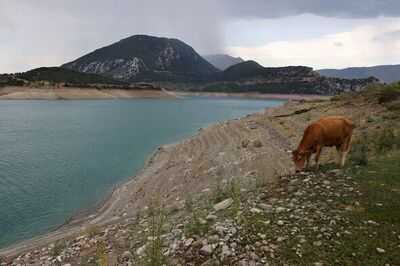European satellite images have sparked fear in Greece after new images revealed a dramatic decline in the size of Lake Mornos, an artificial reservoir in the centre of the country that is a primary and vital source of water for Athens. Between January 2022 and October 2025 - a period of less than four years - the lake lost nearly half of its total water volume. The surface water extent decreased from some 7.4 square miles to a concerning 3.6.
The satellite images - from the Copernicus Sentinel-2 satellite - a European mission with two polar-orbiting satellites monitoring land surface conditions - clearly show the lake's recession. Large stretches of former shoreline and lakebed are now visible, particularly around the narrow central section and near the dam structure. What's more, the community of Lidoriki is now situated much closer to the exposed ground rather than the water's edge.

The decrease has been attributed to prolonged drought and reduced rainfall in recent years, part of a broader, climate change-driven trend affecting the Mediterranean region, according to the Greek Reporter. Warmer surface temperatures have exacerbated the problem, by significantly increasing the rate of water loss due to evaporation.
The crisis has severely strained Athens's entire water management system, which is run by the EYDAP water company. The reduced volume affects the efficiency of the dam's operation and the quality of water that can be drawn from the reservoir's lower depths. The depletion of Mornos puts immense pressure on Athens' other water sources, such as Lake Yliki and Lake Marathon.
It will also affect local ecosystems, as a rapid reduction in water depth and surface area disrupts aquatic habitats, affecting fish populations and the broader local wildlife that depend on the lake. Local communities, like Lidoriki, which may depend on the reservoir for tourism and other activities, may also face economic hardship.

Drought has become a major concern in Europe in recent years. In the Danube River in northern Europe, water levels dropped so significantly that numerous German warships from World War 2 were revealed. These wrecks, sunk in 1944 to block Soviet forces, are now surfacing in places like Serbia and Hungary.
In January, Brits heading to Spain were warned as several popular holiday hotspots like the Costa del Sol, Malaga and Alicante faced severe droughts. Despite early rainfall at the start of the year, water reserves in the southern half of Spain remained critically low, with experts warning that the situation was far from resolved. At the time, the Public Sanitation and Supply Association stressed that the Costa del Sol in particular was under "emergency" drought conditions, with water-saving measures enforced to safeguard the region's supply.
In Malaga, reservoir levels were just 28%, a slight improvement over last year's low of 16%, but still significantly lower than a decade ago, when they were at 48%.
"These challenges underline the urgent need for more resilient water management," the report stated, linking the crisis to the broader effects of climate change.
You may also like

Campaign for Budgam bypoll begins, Omar government faces first test of popularity

Phil Mickelson rages over 'illegals committing crimes' after pleading with Donald Trump

Liverpool pay emotional tribute as kit manager Jonathan Humble dies suddenly

PKL 12: Vinay stars as Haryana Steelers beat Telugu Titans by 11 points, solidifying Top-Four chance

Kemi Badenoch takes on Jenrick as she insists burka ban 'not a priority'







